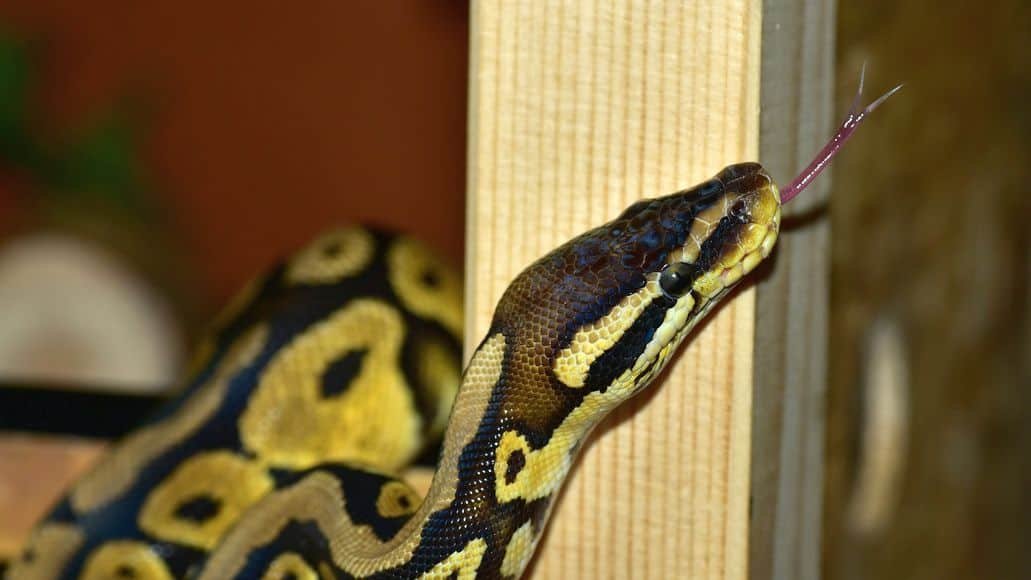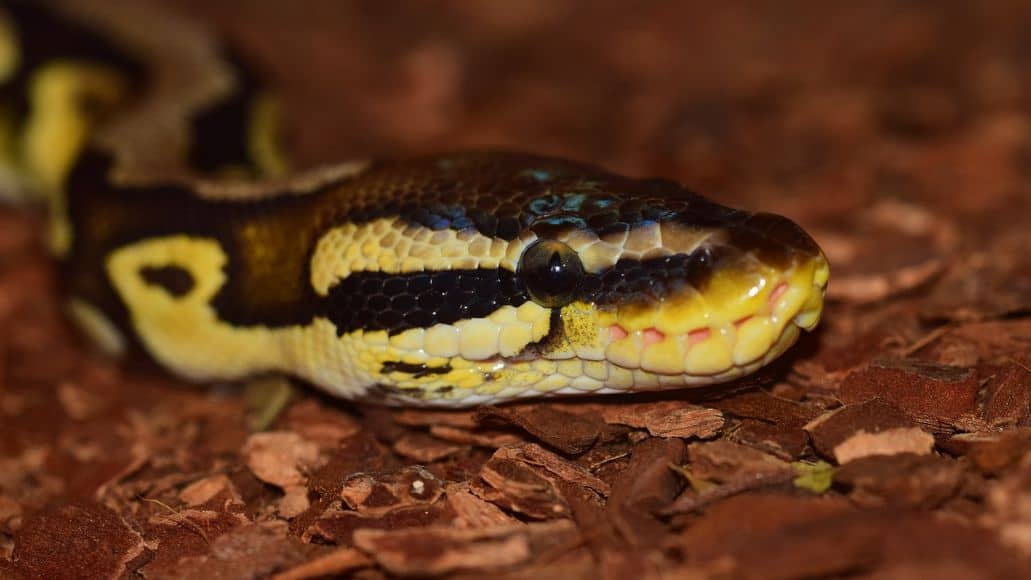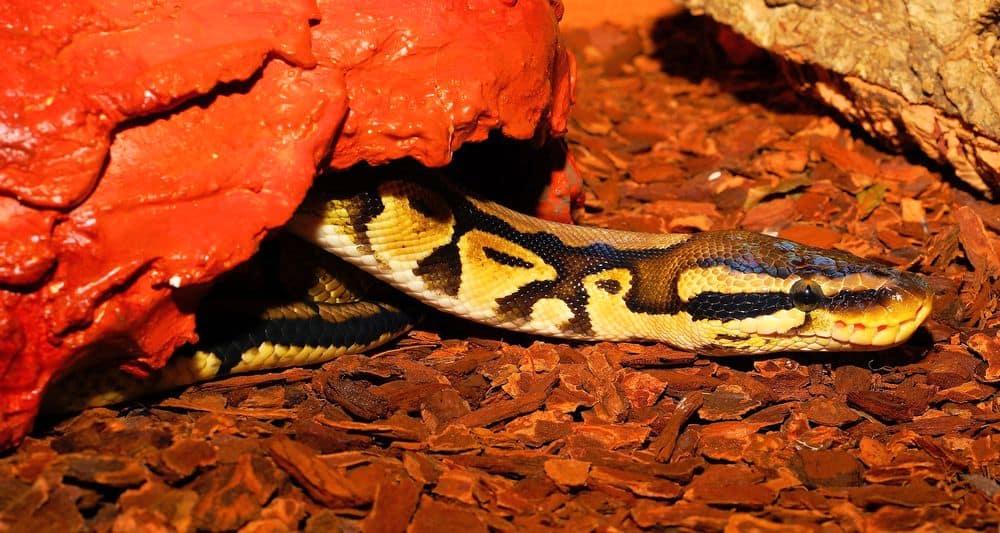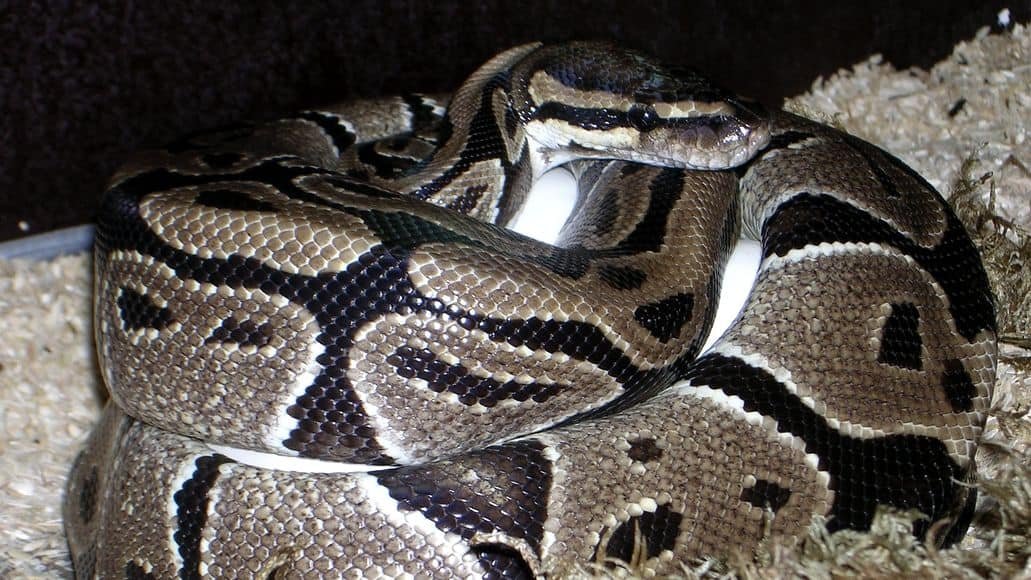
And the closest you can get in your home is a bioactive enclosure.
Of course, setting up such an enclosure is more difficult.
But it’s still pretty simple, if you know how to create a bioactive enclosure for your ball python.
And that is exactly what I am going to help you with today.
Keep reading for an easy step-by-step guide to setting up a bioactive ball python terrarium.
Table of Contents
- 1 How To Create A Bioactive Enclosure For Your Ball Python
- 1.1 Step 1: Choose The Right Tank For Your Enclosure
- 1.2 Step 2: Create A Basic Layout
- 1.3 Step 3: Choose The Background
- 1.4 Step 4: Choose The Substrate
- 1.5 Step 5: Add Hides And Hardscape Items
- 1.6 Step 6: Add In Healthy, Hardy, And Safe Plants
- 1.7 Step 7: Add Cleanup Critter
- 1.8 Step 8: Add Lights And Heat To The Enclosure
- 1.9 Step 9: Maintain The Enclosure
- 2 Bioactive Enclosure For Ball Pythons: Final Thoughts
How To Create A Bioactive Enclosure For Your Ball Python
Follow these 9 steps to set up a bioactive enclosure for your pet ball python.
Step 1: Choose The Right Tank For Your Enclosure

When choosing an enclosure for your ball python’s bioactive setup, select a robust tank that can comfortably accommodate your snake. A glass aquarium or tank is ideal, though fully enclosed wooden or PVC enclosures also work well.
The minimum size should be at least 4 feet long, 2 feet wide, and 2 feet tall to provide ample space for your ball python to move and explore.
Ensure you have adequate space to keep the tank, considering both the dimensions of the enclosure and the space required for maintenance and ventilation.
Place the bioactive enclosure in a quiet area with stable temperatures, away from direct sunlight and drafts. Avoid placing the tank near windows, air vents, or high-traffic areas to reduce stress for your ball python and maintain optimal environmental conditions.
Step 2: Create A Basic Layout
A bioactive terrarium should, ideally, have a nice natural landscape. You can choose between a sandy beach, a lush rainforest, or a desert oasis.
Ball pythons are typically found in grasslands, open forests, and areas with some cover. This can give you an idea about its basic layout, particularly, the background and hardscape items to include in it.
Consider drawing a rough sketch of the terrarium so you know what goes where. Check out the images and videos of bioactive enclosures online. Take notes or download pictures of what you like. Connect with the Herp Community to brainstorm ideas.
Step 3: Choose The Background
When creating a bioactive enclosure for your ball python, the background of the tank is important for both aesthetics and enrichment. You can use commercially available backgrounds or make DIY custom backgrounds using non-toxic materials. Securely attach the background materials to make it safe for your ball python.
Craft A DIY Bioactive Background
A custom-crafted or DIY background can help set the stage for a more natural habitat for your bally. Consider using materials like Styrofoam or expanding foam to sculpt custom backgrounds.
These materials are lightweight, easy to shape, and provide texture for your snake to climb. Use silicone glue to secure them and a hot wire foam cutter for shaping the foam. Take your time to experiment with the layout before finalizing it.
Step 4: Choose The Substrate

Next, you need to choose a proper substrate for your ball python’s bioactive enclosure. Ideal substrates include a mix of coconut fiber, topsoil, and leaf litter. These provide a natural environment and support beneficial microfauna.
You can also make your own DIY substrates by combining organic topsoil, coconut coir, and sphagnum moss. Ensure that the substrate retains moisture without becoming waterlogged.
Make sure to maintain the substrate by spot-cleaning it daily. This entails removing the waste and turning and replacing it regularly to prevent mold. Periodically, add fresh leaf litter and topsoil to keep the environment clean, dry, and healthy.
Add A Drainage Layer
Establishing a drainage layer helps maintain a balanced environment for your terrarium plants and prevents root rot. A drainage layer also prevents waterlogged conditions and ensures proper moisture levels and root health for plants.
Use materials like gravel, clay balls, or activated charcoal that allow the excess water to drain away from the substrate above it. Avoid using fine sand or soil, which can clog the drainage layer.
Step 5: Add Hides And Hardscape Items
For the enclosure’s hardscape (natural decorative materials), choose elements like rocks, branches, and hides. You can easily find these at pet stores and garden centers, or collect them from nature.
There are also many snake branches and snake hides available on Amazon. If you collect items from outdoors, make sure to sterilize them properly before placing them in the tank.
Sterilize The Hardscape Items
Sterilize the rocks, hideouts, and branches in an oven by baking them at 200° F for an hour. Alternatively, you can soak them in a bleach solution (1 part bleach to 10 parts water) for 24 hours. Thoroughly rinse and sun-dry the items before adding them to the enclosure.
A Note On Types Of Hides

Hides are crucial in a ball python’s bioactive enclosure, because they provide security and stress relief. They also help the ball python regulate its body temperature. Hides should, ideally, be of the following types:
- Warm hides: these offer a cozy retreat for digestion and shedding.
- Cool hides: these provide a cooler area for thermoregulation.
- Humid hides: these maintain higher humidity levels and aid the snake in shedding.
You can buy ready-made hides, or craft them using materials like cardboard boxes or plastic containers. Ensure that they have a snug fit without being too cramped. Place hides strategically to mimic natural hiding spots and promote comfort for your ball python.
Step 6: Add In Healthy, Hardy, And Safe Plants
Live plants are essential for a ball python’s bioactive enclosure, because they provide enrichment and natural aesthetics and also maintain humidity levels.
Choose The Plants
- Choose hardy plants like pothos, snake plants, and spider plants, which are safe for ball pythons and can withstand the enclosure’s conditions. (A word of caution: do not add too many Pothos plants, because they tend to need lots of pruning, grow quickly, and will take over if left unattended.)
- For the foreground, consider low-growing plants such as creeping figs or baby tears.
- In the mid-ground, options like bromeliads and philodendrons add depth.
- Background plants like Ficus trees or bamboo palms can provide privacy and climbing opportunities.
Ensure that the plants are non-toxic and robust enough to withstand the python’s movements.
Tips For Planting
- Always purchase the plants after setting up the tank, for stability. Reptile expos offer diverse plant selections, ideal for bioactive setups, so, do try to visit those.
- Quarantine new plants to prevent introducing pests into the enclosure. Also, clean the plants by gently rinsing their leaves to remove dust.
- Transplant shock can occur when you move plants. Allow plants time to acclimatize before introducing your ball python. This will ensure that they settle into and thrive in their new environment.
- Water the plants manually to monitor moisture levels, or you can use automatic watering systems for consistency.
Step 7: Add Cleanup Critter
Cleanup critters are essential for maintaining a healthy environment in your ball python’s enclosure. Isopods and springtails are the main ones. They help break down waste and prevent mold growth.
Always purchase your cleanup critters after setting up the enclosure and introduce them after you have created the substrate. You can start your own colony too. Just place them in a separate container with moist substrate and leaf litter.
You need to care for the critters by maintaining humidity and providing food like decaying plant matter. Regularly check their population and replenish as needed to keep your bioactive enclosure clean and balanced.
Step 8: Add Lights And Heat To The Enclosure

Proper lighting and heating are crucial for your ball python’s bioactive enclosure.
- Use full-spectrum lights for plant growth and a heat gradient to regulate your snake’s temperature.
- Heat lamps with incandescent, ceramic, or halogen bulbs are great choices.
- Ball pythons don’t need UVB lighting, but the use of UVB could boost immunity. So consider adding them.
- For heating, consider under-tank heaters or radiant heat panels.
- To cool the enclosure, use fans or place it in a cooler room.
Maintain the right temperature and lighting to ensure a healthy, thriving environment for your ball python and plants.
Step 9: Maintain The Enclosure
The following steps can help you create a thriving, low-maintenance bioactive habitat for your ball python.
- Trim plants regularly to prevent overgrowth and keep replacement plants ready.
- Replenish the cleanup critter population to maintain balance.
- Maintain healthy soil by turning it occasionally and adding fresh, clean, and dry substrate.
- Clean the glass regularly to ensure visibility and remove dead plants, uneaten food, shed skin, and feces promptly.
- Monitor temperature and humidity levels consistently and tweak them as needed.
- Keep a written maintenance schedule to track tasks and ensure a healthy environment.
Bioactive Enclosure For Ball Pythons: Final Thoughts
Creating a bioactive enclosure for your ball python is a rewarding endeavor that not only enhances the aesthetic appeal of the habitat but also promotes the well-being of your pet. By following the outlined steps, you can establish a self-sustaining environment that mimics your snake’s natural habitat.
Regular maintenance and monitoring are essential to ensure the enclosure remains healthy and balanced. With proper care and attention, your ball python will thrive in its bioactive home, enjoying a more enriched and natural lifestyle.
Leave a Reply